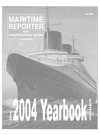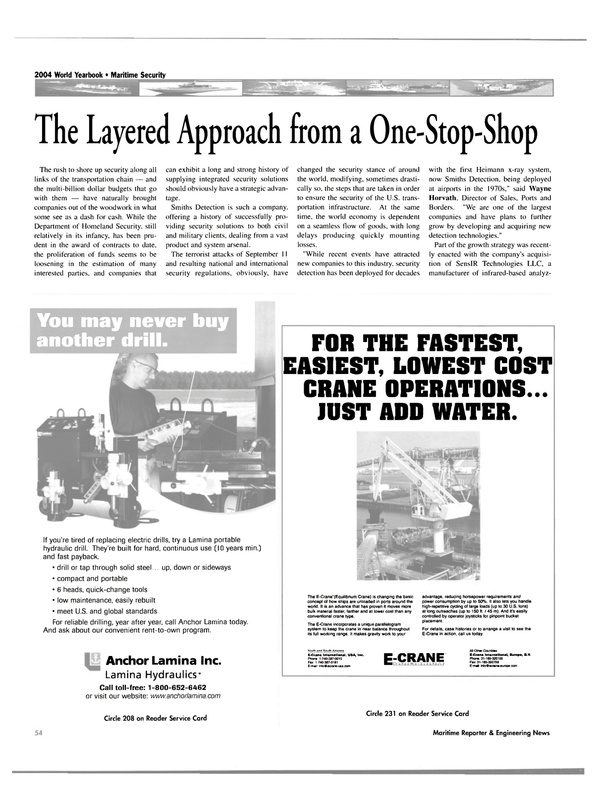
The Layered Approach from a One-Stop-Shop
The rush to shore up security along all links of the transportation chain — and the multi-billion dollar budgets that go with them — have naturally brought companies out of the woodwork in what some see as a dash for cash. While the Department of Homeland Security, still relatively in its infancy, has been prudent in the award of contracts to date, the proliferation of funds seems to be loosening in the estimation of many interested parties, and companies that can exhibit a long and strong history of supplying integrated security solutions should obviously have a strategic advantage.
Smiths Detection is such a company, offering a history of successfully providing security solutions to both civil and military clients, dealing from a vast product and system arsenal.
The terrorist attacks of September 11 and resulting national and international security regulations, obviously, have changed the security stance of around the world, modifying, sometimes drastically so, the steps that are taken in order to ensure the security of the U.S. transportation infrastructure. At the same time, the world economy is dependent on a seamless flow of goods, with long delays producing quickly mounting losses.
"While recent events have attracted new companies to this industry, security detection has been deployed for decades with the first Heimann x-ray system, now Smiths Detection, being deployed at airports in the 1970s," said Wayne Horvath, Director of Sales, Ports and Borders. "We are one of the largest companies and have plans to further grow by developing and acquiring new detection technologies." Part of the growth strategy was recently enacted with the company's acquisition of SensIR Technologies LLC, a manufacturer of infrared-based analyz- ers, for a total of $75 million ... the second acquisition for Smiths Detection in 2004.
SensIR supplies analyzers for the identification of potentially hazardous substances in solid and liquid form. Its products are principally used by military forces and the emergency services, notably first responders, hazmat (hazardous material) teams and fire services worldwide.
The acquisitions help to complement an already impressive product line-up.
that includes these non-intrusive inspection sources: Trace detection: Biological Agent Detection: Chemical Agent Detection: Explosives Detection; Forensic; Fuel Vapor Monitoring; Meteorological Measuring; and Narcotics Detection. Horvath counts this breadth as strategically advantageous.
"No single product is capable of mitigating all potential threats." He notes that there is no "silver bullet" security solution. Growing opinion among security professionals confirms that the layering of multiple technologies offers the greatest level of protection.
"Its extensive range of detection technologies allows Smiths Detection to secure access points from multiple threats, as opposed to the single product providers that have traditionally occupied this space." For more information from Smiths Detection Circle 4 on Reader Service Card
Read The Layered Approach from a One-Stop-Shop in Pdf, Flash or Html5 edition of June 2004 Maritime Reporter
Other stories from June 2004 issue
Content
- New Joint Venture Tanker Company Sets Sail page: 9
- Crowley Refloats Stranded Passenger Ferry page: 10
- A Tradition Carried On page: 10
- EC: Spanish Shipyards Owe €308.3M page: 11
- Uljanik Delivers for Grimaldi-Napoli page: 12
- Washburn & Doughty delivers Independent page: 13
- Bollinger Repowers, Modifies 40-Year-Old Tug page: 14
- ACBL Announces Sweeping Changes page: 18
- Ocean Policy Study: Shortchanging Water Transport? page: 21
- Damen Delivers the Patrol Boat Valiant page: 25
- IZAR Christens LNG Ship page: 25
- Challenges facing IMO page: 26
- Flood Attracted to Water page: 30
- The Containership Market: Full Steam Ahead? page: 32
- Will Oil Continue Heading Up? page: 34
- Floating Production: The $8 Billion Market page: 36
- LNG Fleet Needs to Triple by 2020 page: 38
- New Free Fall Lifeboat Carries More People page: 41
- Wartsila to Power New DE Tanker page: 41
- Ice Tech: The Northern Promise page: 42
- New Era for Gas Engines page: 42
- Emulsion Breaking Bilge Water Cleaning System page: 44
- Balancing Security Safety and Commerce page: 46
- When the Clock Strikes Midnight page: 50
- The Layered Approach from a One-Stop-Shop page: 54
- JHOC: Eyes Wide Open page: 58
- The Posse Comitatus Act of 1878 page: 61
- Jacksonville Selects ObjectVideo's Solution page: 63
- Ship@Sight SSAS page: 63
- The Midas Touch page: 64
- Security and Safety: Questions & Answers page: 69
- Storm Warnings Raised over Readiness Concerns page: 70
- MACC 2004: Multi-Agency Craft Conference set for June 15-17 page: 76


